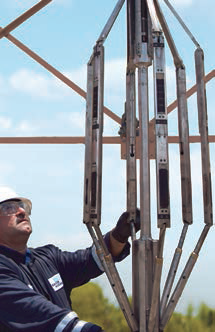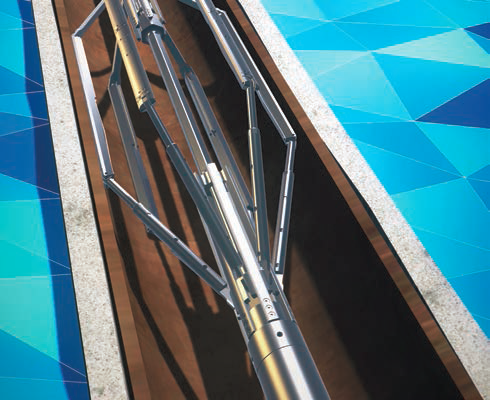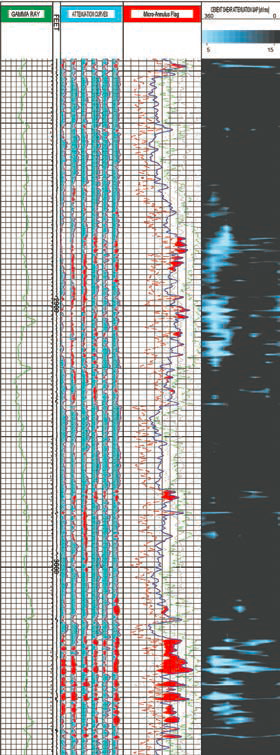Cemented tubulars provide isolation between the environment and flowing production fluids. Operators in the upstream sector of the oil and gas industry rely on the accuracy of cement-bond logs to make critical decisions that can affect long-term well integrity and the environment. Several downhole conditions, such as thick casings, heavy borehole mud and low-density cement, pose potential problems to the acquisition of representative cement evaluation data.
The most challenging conditions occur when cement becomes contaminated with borehole mud during the cementing process and when low-density cement is used. Both of these conditions decrease the acoustic impedance properties of the cement, which makes it invisible to traditional acoustic-based cement evaluation services.
A new evaluation service that uses electromagneticacoustic transducer sensor technology holds the potential to significantly improve the way the cement integrity of oil and gas wells is evaluated. This new technology, which forms the basis for the Baker Hughes Integrity eXplorer cement evaluation service, allows operators to directly assess the integrity of cement bonds in any current wellbore environment or cement mixture.

Direct measurement of cement strength
While cement compressive strength has typically been used as a key indicator of cement quality, today’s challenging environments require a more detailed assessment. The shear acoustic mode generated by the electromagnetic-acoustic transducers provides a new foundation for cement evaluation by responding to the cement shear modulus, which is a true indicator of solid cement behind the casing.
Radical change in low-density cement evaluation
Lightweight cements with densities as low as 7 parts per gallon (ppg) are used in the industry today to reduce the downhole cement hydrostatic pressure column to accomplish a seal across highly depleted and weaker formations without fracturing them unintentionally. It is estimated that 30% of new oil and gas wells use these lightweight cement slurries. Existing acoustic-based cement evaluation technologies rapidly lose dynamic resolution as the density of these cements drops
below 11 ppg.
These traditional services perceive contaminated or lightweight cement as a partial or nonexistent bond. The new service provides a noncontact excitation of shear and lamb acoustic modes that overcomes the challenge of evaluating these types of
cements. The shear horizontal mode that is used to evaluate these lightweight cement slurries cannot be generated by conventional acoustic transducers.
The service provides accurate information that helps operators gain a better understanding of the cement-bond—regardless of weight or contamination—to make critical decisions regarding long-term zonal isolation with greater confidence. Capable of accurately measuring the cement bond regardless of the type or presence of fluid in the wellbore, the service eliminates the need to unnecessarily add wellbore fluids for evaluation. By generating acoustic waves directly on the casing, measurements can be provided in air-filled boreholes and gas-cut mud systems.
Identification of microannuli presence
Evaluation of the cement bond in zones with microannuli is critical for assessing the necessity of remedial cement squeeze jobs. When a microannulus is present, a thin micron-scale gap develops between the cement and casing. Conventional cement evaluation services perceive the casing as free, even though cement is present.
With the help of the acoustic lamb (flexural) mode, the electromagnetic-acoustic service eliminates the need for, and associated time and expense of, procedures to pressurize the casing for evaluation. In a single pass into the wellbore, the service’s proprietary sensor technology enables detection of the presence of a microannulus and the quality of cement behind it.
Advantages in demanding environments
Tool eccentricity has historically posed a challenge to cement-bond evaluation services. The new service, with the help of its six-pad design, avoids this situation as the magnetic force present between the pads and the casing maintains physical contact between the two. The pads are designed and engineered to make the sensors insensitive to moderate tool decentralization. As a result, log quality is not compromised. This capability is valuable for demanding deployments in highly tortuous wellbores.
The fact that the service can be used with the service company’s existing fleet of wireline openhole formation evaluation instruments provides an efficient method of saving rig time by assessing the formation through the casing while performing the
required cement evaluation. Data from the service are provided at the rig site.

Successful cement evaluation in air-filled borehole
Operators in the northern U.S. store natural gas for future use in underground gas storage (UGS) wells. Evaluating cement for zonal isolation in these wells has proved costly because of the time and resource-intensive nature of the operation.
Conventional cement evaluation services require operators to relieve stored gas pressure, kill the well and fill the wellbore with liquid to achieve effective cement evaluation data. To minimize losses, operators wait until the well pressure is lower than the well discovery pressure. However, this condition typically occurs only once a year, significantly limiting the time when cement evaluation in these wells is possible.
To reduce operational cost, safety and environmental implications, operators need the flexibility to log these UGS wells for cement evaluation whenever desired. To address this need, the new cement evaluation service was applied in two gas-filled wells under pressure.
The service successfully provided cement evaluation data without fluids in the borehole. The data that were acquired matched previous data obtained from the same well several years ago in the presence of borehole fluids. This comparison gave the operators the reassurance they needed to ascertain the presence of long-term zonal isolation.
Operational and remedial expenses were significantly reduced by eliminating the need to set a plug, fill the well with fluid for cement evaluation and then reverse the process to restore the storage functionality.

Recommended Reading
Origis Secures $1B in New Investments from Brookfield, Antin
2025-01-15 - Brookfield Asset Management is joining Origis Energy’s investor group alongside existing investor and majority owner Antin Infrastructure Partners.
Exxon’s Upstream President Liam Mallon to Retire After 34 Years
2024-12-03 - Exxon Mobil’s board has appointed Dan L. Ammann, currently Exxon’s low carbon solutions president, to assume Liam M. Mallon’s roles.
Argent LNG, Baker Hughes Sign Agreement for Louisiana Project
2025-02-03 - Baker Hughes will provide infrastructure for Argent LNG’s 24 mtpa Louisiana project, which is slated to start construction in 2026.
Ovintiv Names Terri King as Independent Board Member
2025-01-28 - Ovintiv Inc. has named former ConocoPhillips Chief Commercial Officer Terri King as a new independent member of its board of directors effective Jan. 31.
Transocean President, COO to Assume CEO Position in 2Q25
2025-02-19 - Transocean Ltd. announced a CEO succession plan on Feb. 18 in which President and COO Keelan Adamson will take the reins of the company as its chief executive in the second quarter of 2025.
Comments
Add new comment
This conversation is moderated according to Hart Energy community rules. Please read the rules before joining the discussion. If you’re experiencing any technical problems, please contact our customer care team.





